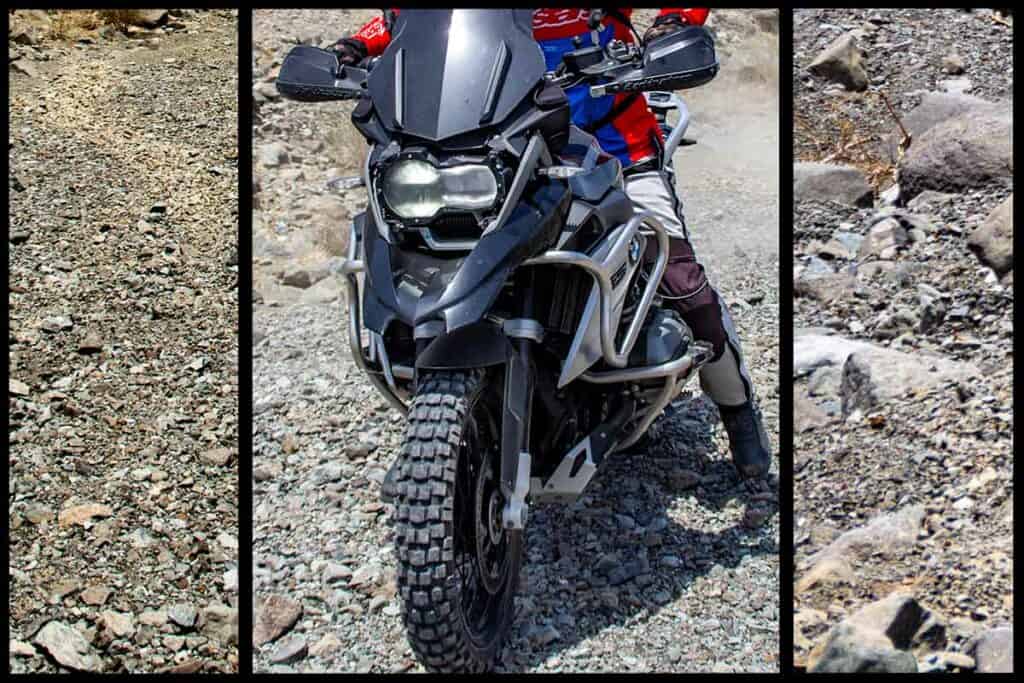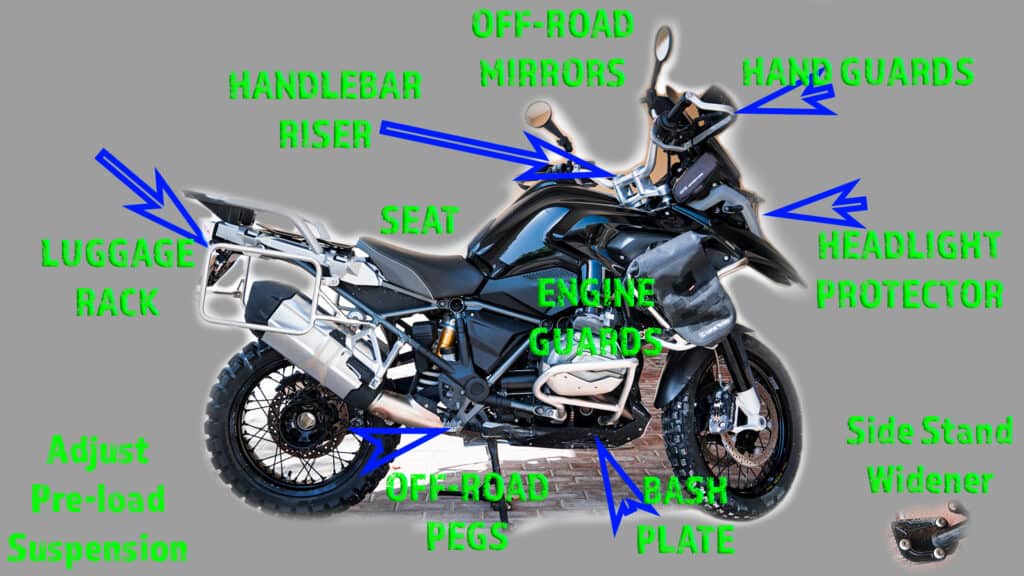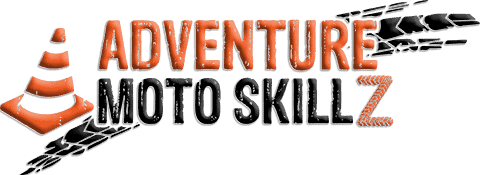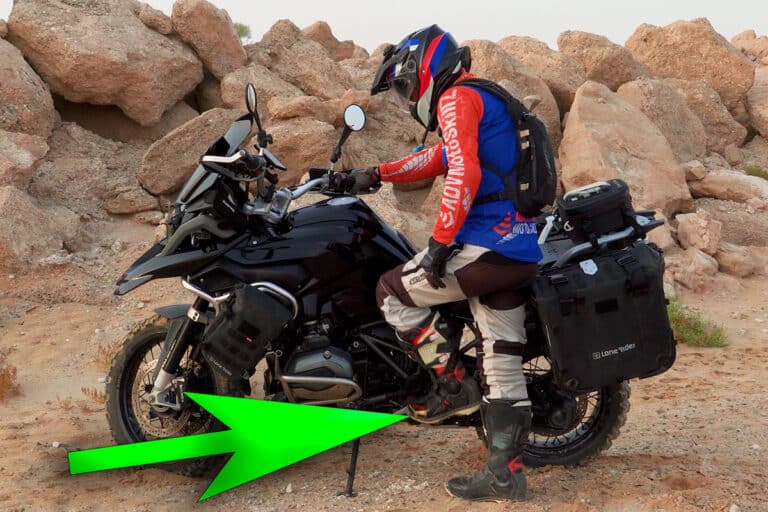5 Tips To Riding Big Adventure Bikes Off-Road – Riding Gravel & Hard Pack
When it came time for me to switch over from road riding to off-road riding, I knew exactly what I needed: experience with gravel and hardpack roads. A second-hand BMW G650 Sertao got me started as I took off-road training courses and then practiced the drills constantly. Today, as a certified off-road instructor, I get the opportunity to teach other riders how to tackle gravel and hard-pack terrain.
Gravel and hard pack off-road motorcycle training focuses on 5 key areas:
- Vision – have a good line of sight to plan your next move
- Momentum – keep steady forward movement
- Cornering – learn how off-road and on-road cornering differ
- Weight the pegs – use proper body position to guide your ride
- Bike set up – let the bike ergonomics match your needs
This post may contain Affiliate Links. Please see our Privacy & Disclosure Policy for more details.

It is estimated that 80% of the world’s roads are unpaved, so just think of all the riding opportunities! Let’s review the same tips I give my students during gravel training and set you up for off-road success.

Top-quality gear for your next adventure
Used and recommended by ADVMotoSkillZ
TIP #1
Look ahead & scan the trail – the bike will follow your eyes
“Look where you want to go” is standard advice for all motorcycle riders. But what does it really mean, and how do we practically do it?
When off-road, the rough surface of gravel or the dips in hardpack can cause the front tire to slide or get knocked around. If a pothole has ever caught you off guard on the road, you already understand what it’s like to have uneven ground throw your bike off-line.
When we “look where we want to go,” we are actually looking forward to the destination we want the bike to travel to (for example, the turn-in point of a corner). Always avoid staring down at the front tire or over-analyzing the uneven terrain that is knocking the front tire about. This advice is simply reminding us to keep our focus ahead as the bike moves around beneath us, to guide it in the direction of our line of sight.
TARGET FIXATION IS VERY REAL
If you are riding your bike down the highway and suddenly see a large section of blown-out truck tire in your lane, will you keep your focus solely on the tire? Or will you quickly scan your immediate surroundings and then look up ahead to find a safe and clear line to move towards? Of course, the latter is the safest option; otherwise, your fixation on the tire would likely cause you to hit it.
Take a look here for some examples of what we are talking about:
Honing your vision skills takes practice. One of the first drills I recommend is a cone weave with different lines of sight:
- Place 6 cones in a straight line 4-5 meters/yards apart
- Perform the cone weave by fixating your vision only on the cone directly in front of you
- Repeat the cone weave, but this time look 2-3 cones ahead
Keep practicing until you can scan your vision out ahead, then back to the closet cone and out again as needed. Practicing your vision this way will transform the skill into a natural habit on each ride. Riding uneven gravel terrain will seem much easier with good visual skills and will make you a better rider out on the trails. Looking ahead allows you to choose the best line to ride to keep traction and momentum (our next topic)!
TIP #2
How to use momentum to your advantage when riding gravel
Big adventure motorcycles come with big power. We can better negotiate gravelly roads by learning to control this energy and leveraging it through precise throttle inputs. When we keep the motorcycle moving at a steady pace, it becomes easier to maintain control and avoids getting bogged down or stuck.
Big throttle inputs on gravel often lead to one of two outcomes:
- the front tire washing out … sliding uncontrolled in a corner resulting in a fall… OR
- the rear wheel spinning, throwing rocks onto your riding buddy behind you, and maybe tipping the bike down
SLOW & STEADY = SMOOTH & STABLE
It is easy to fall in love with the sensation of twisting that throttle back and ripping it up on a hard pack or gravel road. But the truth is that anyone can simply ride fast; however, it takes skill and discipline to master slow and deliberate riding. That is why this skill has always been something I’ve continuously worked to improve throughout my motorcycle riding career.
When riding on low-traction surfaces like gravel, it is important to keep your speed at a comfortable pace for your skill and experience. Hitting a loose patch of gravel too fast or too slow can quickly lead to a stuck or downed bike. However, traveling at a comfortable and steady pace will allow for smooth friction zone use, blipping, and braking to successfully conquer the challenge.

Innovative Motorcycle Tool Sets – Compact & Reliable
Used and recommended by ADVMotoSkillZ
Big braking inputs will cause the same front tire wash-out as big throttle inputs will. Instead, keep a steady travel momentum and then gently apply the front brake (especially that first 5% of squeeze) to safely slow the bike.
TIP: Correct overly aggressive braking by releasing the brake and then reapplying with a gentle squeeze (if front brake) or foot pressure (if rear brake).
Here is a quick review of emergency braking on gravel:
TIP #3
Do not corner your bike off-road as you do on the highway
When cornering on pavement at speed, we all know to lean the bike and ourselves into the turn. A few minutes of watching a Moto GP race will highlight this technique nicely. But when riding gravel or other off-road surfaces, cornering must be relearned.
OFF-ROAD CORNERING USES COUNTERBALANCING
Off-road cornering (especially when standing) has the bike leaning into the corner, while you transfer your body weight away from the corner. This is what we call counterbalancing the bike. By simultaneously leaning the bike into the corner and bodyweight away, we press down on the outside peg.
Weighting the outside peg will force the tires to make a larger contact patch area and therefore deliver more grip. Gravel is a low-traction surface, so counterbalancing and weighting the pegs properly will help us regain some needed stability as we turn those corners.

TIP#4
Body position is key to properly weight the pegs
The first bike I owned was a Harley Davidson Street Glide that allowed for extremely relaxed body posture options, and there was never a reason to stand on those full footboards! So when my first off-road instructor started using phrases like “stand up” and “steer with the feet”, I knew my riding style was about to change.
IS "STEER WITH THE FEET" THE RIGHT ADVICE?
Instead of teaching new off-road riders the concept of “steer with the feet”, I prefer to train riders how to properly “weight the pegs” with dynamic body positioning and constant subtle changes in weight distribution. It may seem like a matter of semantics, but reframing a rider to focus on “weighting” instead of “steering” is very impactful.
Gravel riding with a relaxed and flexible body posture with be much more enjoyable than a stiff and rigid posture. Allowing your whole body to flow and shift weight as needed to keep your bike balanced will guide the bike along your chosen path.
Standing while riding an ADV bike has several benefits.
- Ability to see further ahead
- Legs act as shock absorbers
- Ease of shifting weight from side to side or front and back
- Stretch out legs after technical riding
- Nice to cool down on a hot day of riding
The ability to look further down the trail allows for early adjustments to throttle and line selection to better prepare for technical sections or obstacles. Using our legs as secondary shock absorbers will also help smooth out the bumps and help improve traction.
Weighting the pegs becomes easier as body posture is refined to include gripping the bike lightly from the ankles to the knees and having a slight bend in the hips. This posture delivers a feeling of control and unity with your bike that will boost both skill and confidence out on gravel roads.
TIP: Stay light and relaxed on the handlebars so they can better react to the wobbles and bumps. By keeping a good grip with the legs, there will be no need for a death grip on the bars.
TIP #5
Set up your bike for off-road terrain
ADV bikes offer a wide variety of adjustments to match your body type and personal preferences best. We actually dedicated a full blog post to bike ergonomics that you can read here that reviews customizing handlebar positioning and lever tensions. Definitely check that out and make your preferred adjustment.
If you do not plan on frequent off-road riding, then the stock 80/20 tires of most ADV bikes will manage just fine for the occasional gravel road. However, if you will be spending most of your time off-road and are keen to venture further into deep gravel, loose rocks, or water, then investing in a quality pair of 70/30 or 60/40 dual-sport tires will really improve your grip and riding potential.
Reducing tire pressure off-road will increase the tire’s contact patch with the ground and stabilize your ride. Factors that determine the best off-road tire pressure include bike size & weight, terrain, rider preference & rider experience. Research your manufacturer’s recommendations and experiment to find your preferred settings.
ALL THE GEAR ALL THE TIME (For you & your bike)
A natural part of ADV riding involves the occasional tip over, especially as you begin to venture out to challenge yourself with different riding terrain. It is important to protect your bike from these inevitable tip-overs and falls. The investment needed to install engine & radiator crash guards will pay for itself over and over when out on the trails.

Gravel and hard pack terrain is the ideal entry point to off-road riding. Whether you only intend on the occasional dirt road or plan on hitting some singletrack, these 5 tips will serve you well. Get out there and have fun!

About the Author
Coach Mike is a Certified Off-Road Motorcycle Instructor & founder of ADVMotoSkillZ.
Riding tips from ADVMotoSkillZ reach thousands of international riders daily through social & blogs.
Click here to learn more about Mike’s motorcycle evolution from a Harley road rider to finding his true passion for off-road riding on a BMW 1200 GS.
If you would like to send Mike a quick message or invite him to provide training at your local facility, then visit the contact page here.






